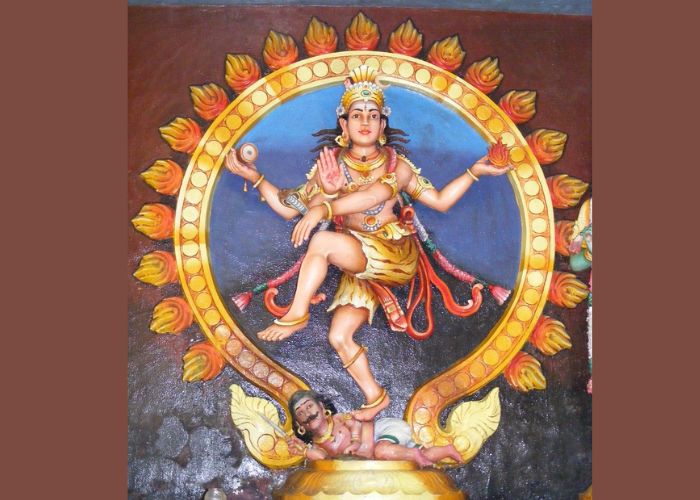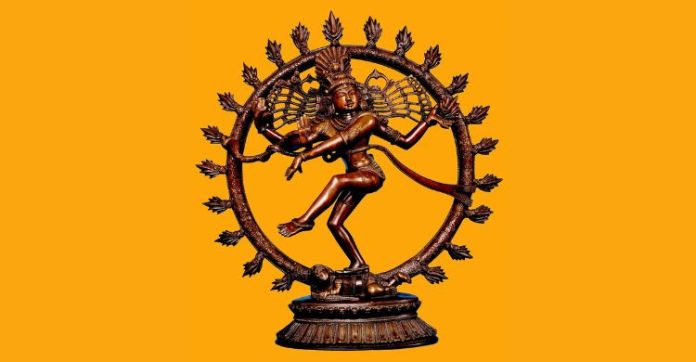In the heart of cosmic chaos, there dances a deity whose every move holds the secrets of the universe—Lord Nataraja, the divine dancer. His Ananda Tandava is not just an artistic expression but a timeless message encoded in movement, rhythm, and symbolism.
The image of Nataraja isn’t merely a religious icon; it’s a profound metaphor for life, balance, creation, and transformation.
Here, we have shared powerful lessons from Nataraja that go beyond spirituality—offering insights for modern living, inner growth, and navigating change with grace.
Lessons From Nataraja
The following are the most important and powerful lessons to learn from Nataraja:
1. Life is a Balance of Opposites
One of the most important lessons from Nataraja is the balance between creation and destruction. In his cosmic dance, Nataraja shows that both are necessary parts of life. He creates with the drum (damaru) and destroys with fire.
This balance teaches us to accept both good and bad times with grace. Just like day and night, success and failure are two sides of the same coin. Instead of resisting change, we must flow with it. Understanding this helps us stay strong in tough times and humble in success. Nataraja reminds us that balance leads to harmony and growth.
2. Stay Calm in the Middle of Chaos
A powerful life lesson from Nataraja is shown in his peaceful face. Even while performing a dynamic dance and controlling the universe, Shiva’s face remains calm and composed. This teaches us the value of inner peace.
No matter how busy or stressful our outer world becomes, we can learn to remain steady from within. In today’s fast-paced world, where distractions are everywhere, this teaching is more important than ever. True strength comes from a calm mind.
Nataraja’s stillness in motion inspires us to find peace in ourselves while handling the chaos of daily life.
3. Ego Must Be Defeated for Growth
One of the essential things to learn from Nataraja is the importance of conquering ego. Under Nataraja’s right foot lies the demon Apasmara, who represents ignorance and arrogance.
By crushing this demon, Nataraja shows us that spiritual and personal growth happens only when we let go of pride and ego. Many of our life problems come from being overly attached to our opinions, status, or identity.
But real freedom begins when we become humble, open-minded, and aware of our inner self. This aspect of the dance reminds us to keep our ego in check and always strive to improve.
4. Constant Change is a Part of Life
A deep lesson from Nataraja is that change is the only constant. His dance reflects the ever-changing nature of the universe—birth, growth, death, and rebirth. This cycle continues endlessly. Often, we fear change or try to avoid it.
But Nataraja’s dance teaches us to accept change as a natural and necessary part of life. Whether it’s a job change, a relationship shift, or personal growth, embracing change helps us evolve. Just like the dance flows without pause, life must go on.
By accepting this truth, we become more adaptable, resilient, and in tune with the rhythm of life.
5. True Wisdom is Knowing What to Create and What to Destroy
One of the most profound teachings of Nataraja lies in his two upper hands—one holding the drum and the other holding fire. The drum represents creation, while the fire represents destruction.
Together, they remind us that wisdom is not just about gaining knowledge, but also about letting go of what no longer serves us. In our daily lives, we must know when to build new habits and when to break old ones.
The same applies to thoughts, relationships, and goals. Nataraja’s form encourages us to reflect, act with awareness, and bring clarity into all areas of our life.
6. Self-Discipline Brings Power and Grace
One remarkable lesson from Nataraja is the power of discipline. The cosmic dance may appear effortless, but it reflects perfect timing, rhythm, and control—qualities that come only through discipline.
In life, we often chase success or peace but overlook the importance of consistent practice and effort. Nataraja’s dance teaches us that discipline is not about restriction, but about aligning with a higher purpose.
Whether in studies, work, or personal growth, having structure and focus can help us move forward with grace. The dance of Nataraja inspires us to develop discipline not just in action, but also in thought.
7. Knowledge Should Be Used to Uplift Others
Another key lesson from Nataraja lies in the gesture of his lower left hand, pointing towards his raised foot. This symbolizes upliftment and liberation. At the same time, the damaru in his upper hand represents the sound of creation—often connected to knowledge, words, and wisdom.
Together, this suggests that the purpose of knowledge is not just self-gain but to help others rise too. In a world full of competition, Nataraja reminds us to use our skills and knowledge to inspire and support.
This is one of the most timeless teachings of Nataraja, promoting kindness, wisdom, and collective growth.
8. Ignorance Must Be Crushed to See the Truth
Among the most important things to learn from Nataraja is the need to defeat ignorance. The demon under Shiva’s foot—Apasmara—is not just an enemy of the gods but a symbol of forgetfulness, laziness, and lack of awareness.
We all have moments when we avoid truth, live on autopilot, or ignore our inner voice. Nataraja’s act of crushing Apasmara is a reminder that if we want a meaningful life, we must overcome ignorance with awareness, learning, and reflection.
Every step toward truth requires courage and effort, but it leads to inner light. Nataraja shows us the path clearly through this act.
9. Everything in the Universe is Connected
A beautiful life lesson from Nataraja is the interconnectedness of all things. His dance happens within a circle of fire, symbolizing the entire cosmos. It shows that every movement, sound, and change has a role to play in the bigger picture.
Sometimes, we feel separate from others or disconnected from our surroundings. But Nataraja teaches us that we are all part of a larger design—interlinked by energy, purpose, and time. Recognizing this connection helps us live more mindfully and treat others with compassion.
In this way, his dance becomes a reminder that unity and awareness are the foundation of peace.
Relevant Topics for You:
Who is Nataraja?
Nataraja is one of the most iconic and powerful forms of Lord Shiva, known as the Cosmic Dancer. The word “Nataraja” means “King of Dance” in Sanskrit. In this form, Shiva performs the Ananda Tandava, the Dance of Bliss, symbolizing the cycle of creation, preservation, and destruction.
This dynamic dance represents the rhythm of the universe and the constant flow of life. Nataraja holds deep significance in Indian philosophy, where he is seen as the force behind cosmic order and transformation.
In spirituality, his dance teaches detachment, balance, and the power of inner stillness. Artists and dancers, especially in Bharatanatyam, consider Nataraja a divine inspiration.
His form—dancing within a circle of fire, with one foot raised and the other crushing ignorance—reminds us of the eternal truth: life is a balance of motion and stillness, destruction and renewal.
Symbolism of Nataraja
The image of Lord Nataraja is filled with deep symbolism. Every part of his form conveys powerful spiritual and philosophical meanings:

- Circle of Fire (Prabhamandala): Represents the universe and the endless cycle of birth, life, death, and rebirth. The fire signifies transformation and constant change.
- Dance (Ananda Tandava): Symbolizes the cosmic rhythm of creation, preservation, and destruction. It’s the dance of bliss that maintains the balance of the universe.
- Upper Right Hand (Damaru): Holds a small drum called damaru, symbolizing the sound of creation and the passage of time.
- Upper Left Hand (Fire): Holds fire, representing destruction—the burning away of ignorance, ego, and illusions.
- Lower Right Hand (Abhaya Mudra): Gesture of fearlessness and protection, assuring devotees to not be afraid.
- Lower Left Hand (Gajahasta or Ardachandra Mudra): Points towards the raised foot, symbolizing liberation.
- Raised Left Foot: Signifies upliftment and spiritual freedom.
- Demon Under Right Foot (Apasmara): Symbolizes ignorance and ego being crushed by wisdom and awareness.
Relevance of Nataraja’s Lessons in Modern Times
Today, the image and teachings of Nataraja are more relevant than ever. His dance is not just a symbol from ancient times—it holds deep meaning for modern life. As we deal with stress, competition, and constant distractions, Nataraja reminds us to find balance between action and stillness, progress and peace.
His crushed demon underfoot symbolizes the ego and ignorance we must overcome to grow. His calm face in the middle of motion teaches us the value of staying centered even when life feels chaotic.
For professionals, students, artists, and seekers alike, Nataraja’s form is a guide. He inspires creativity, discipline, and the courage to embrace change. In a world full of noise, he shows the beauty of silence. In confusion, he brings clarity. That’s why Nataraja is not just a figure of the past—he is a timeless symbol with deep meaning for the present and future.
Must Read About:
Lessons from Guru Shishya Parampara
Yoga | Meditation | Bhagavad Gita | Pranayama | Mental Health
FAQs About Lessons from Nataraja
The dance, known as Ananda Tandava, represents the cosmic rhythm of life, the balance of opposites, and the eternal flow of creation and destruction.
Nataraja teaches balance, inner peace, discipline, the importance of letting go, and the need to overcome ego and ignorance.
The demon, Apasmara, represents ignorance, ego, and forgetfulness. Shiva crushing the demon shows the victory of wisdom over darkness.
Nataraja is a central figure in Indian classical dance, sculpture, and philosophy. His posture and symbols have inspired countless artists and thinkers.
Nataraja reminds us to stay calm in chaos, embrace change, and live with awareness. His symbolism offers deep life lessons even in today’s world.
The fire represents destruction—the burning away of ignorance and the clearing of space for new beginnings.
We can practice self-discipline, stay balanced, embrace change, stay humble, and aim for inner peace, just as Nataraja’s dance teaches.
No, Nataraja is also a symbol of cosmic science, energy, and inner transformation. His image is appreciated in philosophy, physics (even at CERN), and yoga.



